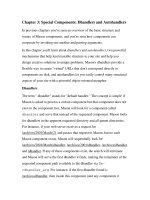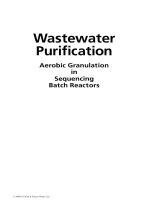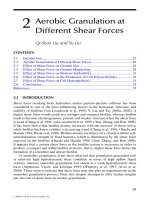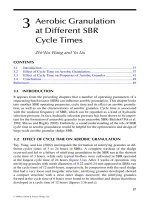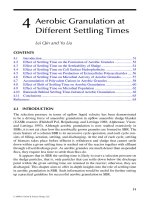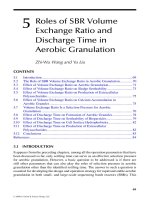Wastewater Purification: Aerobic Granulation in Sequencing Batch Reactors - Chapter 3 potx
Bạn đang xem bản rút gọn của tài liệu. Xem và tải ngay bản đầy đủ của tài liệu tại đây (392.85 KB, 14 trang )
37
3
Aerobic Granulation
at Different SBR
Cycle Times
Zhi-Wu Wang and Yu Liu
CONTENTS
3.1 Introduction 37
3.2 Effect of Cycle Time on Aerobic Granulation 37
3.3 Effect of Cycle Time on Properties of Aerobic Granules 41
3.4 Conclusions 49
References 49
3.1 INTRODUCTION
Itappearsfromtheprecedingchaptersthatanumberofoperatingparametersofa
sequencing batch reactor (SBR) can inuence aerobic granulation. This chapter looks
intoanotherSBRoperatingparameter,cycletimeanditseffectonaerobicgranula-
tion,aswellasonthecharacteristicsofaerobicgranules.Cycletimeisassociated
withthewashoutfrequencyofSBR,whichcanberegardedasakindofhydraulic
selection pressure. In fact, hydraulic selection pressure has been shown to be impor-
tantfortheformationofanaerobicgranulesinananaerobicSBR(HulshoffPoletal.
1982; Shizas and Bagley 2002). Denitely, a sound understanding of the role of SBR
cycletimeinaerobicgranulationwouldbehelpfulfortheoptimizationanddesignof
large-scale aerobic granular sludge SBR.
3.2 EFFECT OF CYCLE TIME ON AEROBIC GRANULATION
Tay,Yang,andLiu(2002)investigatedtheformationofnitrifyinggranulesatdif-
ferentcyclestimesof3to24hoursinSBRs.Acompletewashoutofthesludge
occurredandledtoafailureofnitrifyinggranulationintheSBRrunattheshortest
cycletimeof3hours,whileonlytypicalbioocswerecultivatedinSBRoperated
nitrifyinggranuleswithmeandiametersof0.22and0.24mmappearedinSBRsrun
atthecycletimesof12and6hours,respectively.Incomparisonwiththeseedsludge
that had a very loose and irregular structure, nitrifying granules developed showed
acompactstructurewithaclearoutershape;moreover,thenitrifyinggranules
formedatthecycletimeof6hourswerefoundtobesmootheranddenserthanthose
developedatacycletimeof12hours(gures3.1bandc).
53671_C003.indd 37 10/29/07 7:12:37 AM
© 2008 by Taylor & Francis Group, LLC
© 2008 by Taylor & Francis Group, LLC
atthelongestcycletimeof24hours(gure3.1a).After2weeksofoperation,tiny
38 Wastewater Purification
One outstanding characteristic of aerobic granules compared to bioocs is
theirrelativelylargeparticlesize.Figure3.2showsthatashortcycletimeofSBR
favors the development of large nitrifying granules. A similar phenomenon was
also observed in an upow anaerobic sludge blanket (UASB) reactor, that is, when
theHydraulicRetentionTime(HRT)wasdecreasedfrom10daysto1.5days,the
diameteroftheUASBgranulesincreasedfrom0.56mmto0.89mm(Lin,Chang,
and Chang 2001).
The basis of aerobic and anaerobic granulation is the continuous selection of sludge
particles, that is, light and dispersed sludge is washed out, while heavier components
A
B
C
FIGURE 3.1 MorphologiesofbioparticlescultivatedinSBRsrunatthecycletimesof
24(a),12(b),and6(c)hours;scalebar:1mm.(FromTay,J.H.,Yang,S.F.,andLiu,Y.2002.
Appl Microbiol Biotechnol 59:332–337.Withpermission.)
53671_C003.indd 38 10/29/07 7:12:41 AM
© 2008 by Taylor & Francis Group, LLC
© 2008 by Taylor & Francis Group, LLC
Aerobic Granulation at Different SBR Cycle Times 39
areretainedinthesystem.InanSBR,hydraulicselectionpressuremayresultfrom
thecycletime(ShizasandBagley2002).ThisisduetothefactthattheSBRcycle
timerepresentsthefrequencyofsoliddischargethroughefuentwithdrawal,and
itisrelatedtotheHRT.Thisimpliesthatthelongestcycletimewouldresultinthe
lowest selection pressure. As a result, no nitrifying granulation was observed in the
SBRrunatthecycletimeof24hours.Infact,theabsenceofanaerobicgranula
-
tionwasobservedwhenthehydraulicselectionpressurewasveryweak(Alphenaar,
Visser,andLettinga1993;OFlahertyetal.1997).Nitrifyinggranulesdevelopedwell
inSBRswithcycletimesof12and6hours.Itisevidentthatarelativelyshortcycle
time should suppress the growth of suspended sludge because of frequent washout of
thepoorlysettleablesludge.However,iftheSBRisrunatanextremelyshortcycle
time,forexample,3hours,thesludgelossduetohydraulicwashoutfromthesystem
cannot be compensated for by the growth of nitrifying bacteria. In this case, biomass
cannotberetainedinthesystem,andacompletewashoutofsludgeblanketoccurs
andeventuallyleadstoafailureofnitrifyinggranulation.Asimilarphenomenonwas
alsoreportedinaUASBreactor(Alphenaar,VisserandLettinga1993).
TheeffectofthecycletimeofSBRontheformationofheterotrophicaerobic
granuleswasalsoreportedintheliterature.Wangetal.(2005)usedsucroseasthe
solecarbonsourcetocultivateaerobicgranulesatthecycletimesof3and12hours.
Round aerobic granules rst appeared in the SBR run at the cycle time of 3 hours
after30cyclesofoperation,whileirregularsmallgranuleswereobservedinthe
the evidence points to the fact that in order to achieve a rapid aerobic granulation in
SBR, SBR cycle time needs to be controlled at a relatively low level.
Panetal.(2004)initiatedvecolumnSBRsusingprecultivatedglucose-fedaero
-
bicgranuleswithameansizeof0.88mmasseed,andoperatedthematthecycletimes
of1,2,6,12,and24hours,respectively.ItwasfoundthatbiomassintheSBRrunata
cycletimeof1hourwasentirelywashedoutsoonafterthereactorstart-up,andthisin
Cycle Time (hours)
61224
Sludge Mean Size (mm)
0.09
0.12
0.15
0.18
0.21
0.24
0.27
FIGURE 3.2 Mean size of bioparticles cultivated in SBRs run at different cycle times. (Data
fromTay,J.H.,Yang,S.F.,andLiu,Y.2002.Appl Microbiol Biotechnol 59: 332–337.)
53671_C003.indd 39 10/29/07 7:12:42 AM
© 2008 by Taylor & Francis Group, LLC
© 2008 by Taylor & Francis Group, LLC
SBRoperatedatthecycletimeof12hoursafter120cycles(gure3.3).Sofar,all
40 Wastewater Purification
turnresultedinreactorfailure.IntheSBRwithcycletimesof2to24hours,theseed
granuleswerenallystabilizedafter10to20daysofoperation(gure3.4).Figure3.4a
tocshowsthatattheshortcycletime,aerobicgranulestendedtogrowintolargegran
-
uleswithfewerbioocsinthebulksolution,whileintheSBRrunatthelongestcycle
timeof24hours,amixtureofirregulargranulesandabundantsuspendedbioocs
1.0 mm 1.0 mm
FIGURE 3.3 Morphologies of sucrose-fed aerobic granules cultivated in SBRs run at cycle
timesof3hours(left)and12hours(right),respectively.(FromWang,F.etal.2005.World
J Microbiol Biotechnol 21:1379–1384.Withpermission.)
5 mm
B
FIGURE 3.4 MorphologiesofsludgecultivatedinSBRsrunatcycletimesof2(a),6(b),12(c),
and24(d)hours.(FromPan,S.etal.2004.Lett Appl Microbiol 38: 158–163. With permission.)
5 mm
A
53671_C003.indd 40 10/29/07 7:12:44 AM
© 2008 by Taylor & Francis Group, LLC
© 2008 by Taylor & Francis Group, LLC
Aerobic Granulation at Different SBR Cycle Times 41
wascultivated(gure3.4d).Itcanbefurtherseeningure3.5thatthesizeofstable
granulesturnedouttobeinverselyrelatedtotheappliedcycletime.
3.3 EFFECT OF CYCLE TIME ON PROPERTIES OF
AEROBIC GRANULES
Panetal.(2004)reportedthatalongcycletimedoesnotfavorimprovementin
sludge settleability. For instance, very poor settleability sludge with a high sludge
volumeindex(SVI)of110mLg
–1
wascultivatedintheSBRoperatedatthecycle
timeof24hours.Incontrast,excellentsludgewiththelowerSVIof50mLg
–1
were
Itseemscertainthatashortcycletimecanselectivelyretainbioparticleswithgood
settleability. By virtue of those excellent settleability sludge retained in SBR, high
volatile suspended solids concentrations (VSS), up to 13 g VSS L
–1
,wereachieved
inSBRsrunatshortcycletimes(gure3.7).However,only4gVSSL
–1
was nally
achievedintheSBRrunatthecycletimeof24hours.Inaddition,thequalityof
efuent from SBR run at short cycle times was found to be much better than that
fromthoseoperatedatlongcycletimes(gure3.8).
Comparedtobioocswithloosestructure,aerobicgranulesalwayshavearela
-
tively high biomass density. The specic gravity of sludge reects the compactness
ofthesludgestructure.Figure3.9showsthespecicgravityofnitrifyingsludge
5 mm
C
5 mm
D
FIGURE 3.4 (continued)
53671_C003.indd 41 10/29/07 7:12:46 AM
© 2008 by Taylor & Francis Group, LLC
© 2008 by Taylor & Francis Group, LLC
harvested in the SBRs operated at the cycle times of 2, 6, and 12 hours (gure 3.6).
42 Wastewater Purification
cultivatedinSBRsrunatdifferentcycletimes.Aspointedoutearlier,poorlysettling
sludgewouldbewashedout,andonlybioparticleswithgoodsettleabilitywould
be retained in SBRs run at short cycle times. According to the well-known Stokes
law,amorecompactparticlewouldhaveabettersettleability.Thismayexplainthe
phenomenon shown in gure 3.9, that is, the specic gravity of nitrifying granules
cultivatedatashortcycletimeisindeedmuchhigherthanthosecultivatedatlong
cycletimes.Panetal.(2004)alsoreportedresultssimilartogure3.9,thatis,ashort
cycletimefavorsthedevelopmentofaerobicgranuleswithhighspecicgravity
(gure 3.10). In addition, a high sludge integrity coefcient was obtained at short
cycle times, indicating that aerobic granules with high mechanical strength can be
cultivatedatshortcycletimes(gure3.10andgure3.11).
Cycle Time (hours)
0 5 10 15 2520
Mean Size (mm)
0.5
1.0
1.5
2.0
2.5
3.0
3.5
4.0
FIGURE 3.5 SludgemeansizeinSBRsrunatdifferentcycletimes.(DatafromPan,S.
et al. 2004. Lett Appl Microbiol 38: 158–163.)
Cycle Time (hours)
0 5 10 15 20 25
SVI (mL g
–1
)
0
20
40
60
80
100
120
FIGURE 3.6 Effect of cycle time on sludge settleability. (Data from Pan, S. et al. 2004.
Lett Appl Microbiol 38: 158–163.)
53671_C003.indd 42 10/29/07 7:12:48 AM
© 2008 by Taylor & Francis Group, LLC
© 2008 by Taylor & Francis Group, LLC
Aerobic Granulation at Different SBR Cycle Times 43
As discussed in chapter 9, cell surface hydrophobicity plays an important role
inmicrobialaggregation.Theeffectofcycletimeoncellsurfacehydrophobicityis
showningure3.12.Ascanbeseen,thecellsurfacehydrophobicitywasimproved
as the cycle time was shortened. Higher cell surface hydrophobicity was developed in
SBRsrunatcycletimesof6and12hoursascomparedtothatfoundintheSBRrun
atthecycletimeof24hours.Figure3.1andgure3.12togetherseemtosuggestthat
the formation of nitrifying granules is associated with the cell surface hydrophobicity
inducedbytheshortcycletimeofSBR.Infact,theimportanceofcellsurfacehydro
-
phobicity in biolm and biogranulation processes is demonstrated in chapter 9.
Similarresultstogure3.12werealsoreportedbyPanetal.(2004).Itwas
observedthataerobicgranuleswithhighcellsurfacehydrophobicitywereobtainedat
Cycle Time (hours)
0 5 10 15 20 25
Retained VSS (g L
–1
)
0
2
4
6
8
10
12
14
FIGURE 3.7 Effect of cycle time on suspended solids concentration retained in SBRs.
(DatafromPan,S.etal.2004.Lett Appl Microbiol 38: 158–163.)
Cycle Time (hours)
0 5 10 15 20 25
Effluent VSS (g L
–1
)
0.08
0.12
0.16
0.20
0.24
0.28
FIGURE 3.8 Effect of cycle time on efuent suspended solids concentrations from SBRs.
(DatafromPan,S.etal.2004.Lett Appl Microbiol 38: 158–163.)
53671_C003.indd 43 10/29/07 7:12:49 AM
© 2008 by Taylor & Francis Group, LLC
© 2008 by Taylor & Francis Group, LLC
44 Wastewater Purification
shortcycletimes,forexample,thecellsurfacehydrophobicityatacycletimeof2hours
wasnearlytwotimeshigherthanthatatthecycletimeof24hours(gure3.13).
Itseemscertainthatashortcycletimewouldenhancecellsurfacehydro-
phobicity. Wilschut and Hoekstra (1984) proposed that the strong repulsive hydration
interaction was the main force keeping the cells apart, and when bacterial surfaces
were strongly hydrophobic, irreversible adhesion would occur. According to the
thermodynamicstheory,anincreaseincellsurfacehydrophobicitywouldcausea
corresponding decrease in the excess Gibbs energy of the cell surface, which pro
-
motes cell-to-cell interaction and further serves as a driving force for bacteria to
Cycle Time (hours)
61224
Specific Gravity
1.005
1.010
1.015
FIGURE 3.9 Specic gravity of sludge developed at different cycle times. (Data from
Tay,J.H.,Yang,S.F.,andLiu,Y.2002.Appl Microbiol Biotechnol 59: 332–337.)
Cycle Time (hours)
0 5 10 15 20 25
Specific Gravity
1.03
1.04
1.05
1.06
1.07
1.08
Integrity Coefficient (%)
60
70
80
90
100
110
FIGURE 3.10 Specic gravity (D)andintegritycoefcient($)ofsludgecultivatedin
SBRsrunatdifferentcycletimes.(DatafromPan,S.etal.2004.Lett Appl Microbiol
38: 158–163.)
53671_C003.indd 44 10/29/07 7:12:51 AM
© 2008 by Taylor & Francis Group, LLC
© 2008 by Taylor & Francis Group, LLC
Aerobic Granulation at Different SBR Cycle Times 45
self-aggregate out of liquid phase, that is, a high cell surface hydrophobicity would
result in a strengthened cell-to-cell interaction, leading to the formation of dense and
stable aerobic granule structures (see chapter 9).
Extracellular polysaccharides can mediate both cohesion and adhesion of cells
and play a crucial role in building and further maintaining structure integrity in a
communityofimmobilizedcells(seechapter10).Figure3.14displaystheeffect
of cycle time on the ratio of cell polysaccharides (PS) to proteins (PN) of nitrify
-
ing granules. It is apparent that a short cycle time would stimulate the production
Cycle Time (hours)
123
Integrity Coefficient (%)
80
82
84
86
88
90
92
FIGURE 3.11 IntegritycoefcientofsludgecultivatedinSBRsrunatdifferentcycletimes.
(DatafromWang,F.etal.2005.World J Microbiol Biotechnol 21: 1379–1384.)
Cycle Time (hours)
61224
Cell Surface Hydrophobicity (%)
60
65
70
75
80
85
FIGURE 3.12 Effect of cycle time of SBR on cell surface hydrophobicity of nitrifying
bacteria. (Data from Tay, J. H., Yang, S. F., and Liu, Y. 2002. Appl Microbiol Biotechnol
59: 332–337.)
53671_C003.indd 45 10/29/07 7:12:52 AM
© 2008 by Taylor & Francis Group, LLC
© 2008 by Taylor & Francis Group, LLC
46 Wastewater Purification
of cell polysaccharides over proteins in nitrifying granules. In fact, heterotrophic
addition,thePS/PNratioinheterotrophicgranulescultivatedatthesamecycletime
was nearly two times higher than that produced by nitrifying granules (gure 3.14).
This is mainly due to the fact that nitrifying bacteria cannot utilize organic carbon
fortheirgrowth,andonly11%to27%oftheenergygeneratedgoestobiosynthesis
(Laudelout,Simonart,andvanDroogenbroeck1968),whiletheheterotrophic
bacteria is able to convert up to 70% of the substrate energy into biosynthesis as well
FIGURE 3.13 Effect of cycle time of SBR on cell surface hydrophobicity of glucose-fed
aerobicgranules.(DatafromPan,S.etal.2004.
Lett Appl Microbiol 38: 158–163.)
Cycle Time (hours)
61224
PS/PN Ratio (mg mg
–1
)
2.0
2.4
2.8
3.2
3.6
4.0
FIGURE 3.14 Effect of cycle time on ratio of extracellular polysaccharide (PS) to protein
(PN)ofthesludgefedbyammonia.(DatafromTay,J.H.,Yang,S.F.,andLiu,Y.2002.Appl
Microbiol Biotechnol 59: 332–337.)
53671_C003.indd 46 10/29/07 7:12:54 AM
© 2008 by Taylor & Francis Group, LLC
© 2008 by Taylor & Francis Group, LLC
Cycle Time (hours)
0 5 10 15 20 25
Cell Surface Hydrophobicity (%)
30
40
50
60
70
80
bacteriawerealsofoundtooverproducePSatshortcycletimes(gure3.15).In
Aerobic Granulation at Different SBR Cycle Times 47
as PS production (Rittmann and McCarty 2001). Besides, it has been also reported
that an increased C/N ratio favors the production of cellular polysaccharides, leading
to improved bacterial attachment to solid surfaces (Schmidt and Ahring 1996). In
fact, extracellular polysaccharides are the key bounding material that interconnects
individualcellsintoattachedgrowthandarefurtherresponsibleforthestructural
integrityofthegranularmatrix(seechapter10).
The microbial activity of nitrifying bacteria can be quantied by the specic
nitrication oxygen utilization rate (SNOUR) (Tay, Yang, and Liu 2002). The rela
-
tionshipbetweenSNOURandcycletimeispresentedingure3.16.Itwasfound
that the SNOUR was inversely related to the hydraulic selection pressure in terms
of the SBR cycle time, that is, a shortened cycle time could stimulate the respiration
activity of nitrifying bacteria.
The metabolic network of cells includes interrelated catabolic and anabolic
reactions. The catabolic activity of microorganisms is directly correlated with the
electron transport system activity, which can be described by the specic oxygen
utilization rate. As can be seen in gure 3.16, the SNOUR was proportionally related
tothecycletimeoftheSBR.Ahigherselectionpressureorashortcycletimeresults
in an increased SNOUR. This may imply that the nitrifying community can respond
metabolicallytochangesinthehydraulicselectionpressure.Figure3.17further
shows that the PS/PN ratio increases with the increase in SNOUR. The SNOUR is in
fact correlated with the electron transport system activity that determines catabolic
activity of microorganisms. Therefore, it appears that when the hydraulic selection
pressure imposed on the microbial community is increased, much of the energy
generatedbythecatabolismisusedfortheproductionofcellpolysaccharidesrather
than for growth.
Cycle Time (hours)
0 5 10 15 20 25
PS/PN Ratio (mg mg
–1
)
2
3
4
5
6
7
FIGURE 3.15 Effectofcycletimeontheratioofextracellularpolysaccharide(PS)to
protein(PN)ofthesludgefedbyglucose.(DatafromPan,S.etal.2004.Lett Appl Microbiol
38: 158–163.)
53671_C003.indd 47 10/29/07 7:12:55 AM
© 2008 by Taylor & Francis Group, LLC
© 2008 by Taylor & Francis Group, LLC
48 Wastewater Purification
Itisverylikelythatatahighhydraulicselectionpressure,inordertoavoidbeing
washedoutfromthesystem,thenitrifyingcommunityhastoregulateitsmetabolic
pathway so as to maintain a balance with the external pressure via consuming non
-
growth-associated energy for polysaccharide production. In fact, a decreased biomass
yieldatshortenedcycletimehasbeenreportedbyPanetal.(2004).Figure3.18shows
thatthebiomassyieldobtainedatacycletimeof2hourswasonlyhalfofthatobserved
atthecycletimeof24hours.Robinson,Trulear,andCharacklis(1984)thought
that most of the nongrowth-associated energy was attributable to polysaccharide
FIGURE 3.17 The relationship of SNOUR to PS/PN ratio. (Data from Tay, J. H., Yang, S. F.,
andLiu,Y.2002.Appl Microbiol Biotechnol 59: 332–337.)
Cycle Time (hours)
61224
SNOUR (mg O
2
g
–1
SS h
–1
)
0
50
100
150
200
250
300
350
FIGURE 3.16 Specic nitrication oxygen utilization rate (SNOUR) of sludge cultivated
in different cycle SBRs. (Data from Tay, J. H., Yang, S. F., and Liu, Y. 2002. Appl Microbiol
Biotechnol 59: 332–337.)
53671_C003.indd 48 10/29/07 7:12:56 AM
© 2008 by Taylor & Francis Group, LLC
© 2008 by Taylor & Francis Group, LLC
SNOUR (mg O
2
g
–1
SS h
–1
)
107 211 303
PS/PN (mg mg
–1
)
2.0
2.4
2.8
3.2
3.6
4.0
Aerobic Granulation at Different SBR Cycle Times 49
production, while extracellular redox activity was found to be associated with the
production of extracellular polymeric substances (Wuertz et al. 1998). In fact, it is
well known that the inhibition of the energy-generating function may prevent the
development of competence for cell aggregation (Calleja 1984).
3.4 CONCLUSIONS
ThenatureofSBRisitscycleoperation,thuscycletimeofSBRcanserveasa
hydraulicselectionpressureimposedonthemicrobialcommunity.Completewash
-
outsofbiomassoccuratshortcycletimes,andleadtofailureofaerobicgranulation
inSBRs.Ontheotherhand,aerobicgranulationcouldnotbedevelopedatlongcycle
times because of microbial decay and weak hydraulic selection pressure. Evidence
shows that short cycle time favors the cultivation of strong aerobic granules with
excellent settleability, high specic gravity, and strengthened structure. The enhanced
cell surface hydrophobicity and production of extracellular polysaccharides at short
cycletimealsocontributetorapidandsuccessfulaerobicgranulation.
REFERENCES
Alphenaar,P.,Visser,A.,andLettinga,G.1993.Theeffectofliquidupwardvelocityand
hydraulicretentiontimeongranulationinUASBreactorstreatingwastewaterwitha
high sulphate content.
Bioresource Technol 43: 249–258.
Calleja, G. B. 1984.
Microbial aggregation.BocaRaton,FL:CRCPress.
HulshoffPol,L.W.,deZeeuw,W.J.,Velzeboer,C.T.M.,andLettinga,G.1982.Granulation
in UASB-reactors.
Water Sci Technol 15: 291–304.
Laudelout,H.,Simonart,P.C.,andvanDroogenbroeck,R.1968.Calorimetricmeasure
-
ment of free energy utilization by Nitrosomonas and Nitrobacter.
Arch Mikrobiol 63:
256–277.
Cycle Time (hours)
0 5 10 15 20 25
Yield (g VSS g
–1
COD)
0.05
0.10
0.15
0.20
0.25
FIGURE 3.18 Effectofcycletimeonbiomassyieldofaerobicgranules.(DatafromPan,S.
et al. 2004. Lett Appl Microbiol 38: 158–163.)
53671_C003.indd 49 10/29/07 7:12:57 AM
© 2008 by Taylor & Francis Group, LLC
© 2008 by Taylor & Francis Group, LLC
50 Wastewater Purification
Lin,C.Y.,Chang,F.Y.,andChang,C.H.2001.Treatmentofseptageusinganupow
anaerobic sludge blanket reactor.
Water Environ Res 73: 404408.
OFlaherty,V.,Lens,P.N.L.,deBeer,D.,andColleran,E.1997.Effectoffeedcomposition
and upow velocity on aggregate characteristics in anaerobic upow reactors.
Appl
Microbiol Biotechnol 47: 102–107.
Pan,S.,Tay,J.H.,He,Y.X.,andTay,S.T.L.2004.Theeffectofhydraulicretentiontimeonthe
stabilityofaerobicallygrownmicrobialgranules.
Lett Appl Microbiol 38: 158–163.
Rittmann,B.E.andMcCarty,P.L.2001.
Environmental biotechnology: Principles and
applications. Boston: McGraw-Hill.
Robinson,J.A.,Trulear,M.G.,andCharacklis,W.G.1984.Cellularreproductionand
extracellular polymer formation by Pseudomonas aeruginosa in continuous culture.
Biotechnol Bioeng 26: 1409–1417.
Schmidt, J. E. and Ahring, B. K. 1996. Granular sludge formation in upow anaerobic sludge
blanket(UASB)reactors.
Biotechnol Bioeng 49: 229–246.
Shizas, L. and Bagley, D. M. 2002. Improving anaerobic sequencing batch reactor perfor
-
mance by modifying operational parameters.
Water Res 36: 363–367.
Tay, J. H., Yang, S. F., and Liu, Y. 2002. Hydraulic selection pressure-induced nitrifying
granulation in sequencing batch reactors.
Appl Microbiol Biotechnol 59: 332–337.
Wang,F.,Yang,F.L.,Zhang,X.W.,Liu,Y.H.,Zhang,H.M.,andZhou,J.2005.Effectsof
cycletimeonpropertiesofaerobicgranulesinsequencingbatchairliftreactors.
World
J Microbiol Biotechnol 21: 1379–1384.
Wilschut, J. and Hoekstra, D. 1984. Membrane fusion: From liposome to biological
membrane.
Trends Biochem Sci9:479–483.
Wuertz,S.,Peiderer,P.,Kriebitzsch,K.,Spath,R.,Griebe,T.,Coello-Oviedo,D.,
Wilderer,P.A.,andFlemming,H.C.1998.Extracellularredoxactivityinactivated
sludge.
Water Sci Technol 37: 379–384.
53671_C003.indd 50 10/29/07 7:12:57 AM
© 2008 by Taylor & Francis Group, LLC
© 2008 by Taylor & Francis Group, LLC
